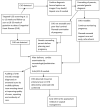Efficacy of Antenatal Ultrasound Examination in Diagnosis of Congenital Cardiac Anomalies in an Unselected Population: Retrospective Study from a Tertiary Centre
- PMID: 34408347
- PMCID: PMC8310828
- DOI: 10.1007/s13224-020-01424-3
Efficacy of Antenatal Ultrasound Examination in Diagnosis of Congenital Cardiac Anomalies in an Unselected Population: Retrospective Study from a Tertiary Centre
Abstract
Background: In Low- and Middle-Income Countries like India, where the services and surgical care for Congenital Heart Disease (CHD) are available only in selected centres with geographical variations, it is important to detect Heart defects early and give the parents an opportunity to plan ahead for seeking appropriate care at the earliest. Several developments in recent years such as improvement of quality of ultrasound machines, sonographer's experience, skills and better description of cardiac views have contributed to improve detection rate.
Methods: A retrospective study was done between March 2016 and December 2019, and showed ultrasound evidence of CHD was included.
Results: The total number of morphology scans done during study period was 50,435. The number of congenital anomalies detected was 1482, out of which CHD was detected in 334 (22.5%). Outcome of 50 pregnancies were not available while the rest (284) were available for follow up in post-natal period. There were 51 cases of CHD, missed on routine antenatal morphological screening, which were diagnosed in the post-natal period. There were 18 cases of over-diagnosed CHD on antenatal scan, but were found to have normal echo findings after birth.
Conclusion: A systematic approach is crucial for practitioner to determine the patterns of associated defects. Use of step wise strategy helps in determining the correct diagnosis of isolated cardiac defect, associated with other system or a part of syndrome. Systematic audit of morphological scans could play an important role in improving the diagnostic accuracy, which in turn will lead to early detection.
Keywords: Cardiac defects; Missed diagnosis; Morphology scan; Perinatal outcome.
© Federation of Obstetric & Gynecological Societies of India 2021.
Conflict of interest statement
Conflict of interestNil, Varunashree ND (VND), Ravi Shankar (RS), Manish Kumar (MK), Preethi Navaneethan, (PN), Santosh Benjamin (SB), Smitha Elizabeth Jacob (SMJ), Bijesh Yadav (BY) and Swati Rathore (SR) declare that they have no conflict of interest.
Figures
References
-
- Bahtiyar MO, Copel JA. Screening for Congenital Heart Disease During Anatomical Survey Ultrasonography. Obstet Gynecol Clin. 2015;42(2):209–23. https://www.obgyn.theclinics.com/article/S0889-8545(15)00015-7/abstract. Accessed 5 Dec 2020. - PubMed
-
- Birth prevalence of congenital heart disease: A cross-sectional observational study from North India Saxena A, Mehta A, Sharma M, Salhan S, Kalaivani M, Ramakrishnan S, Juneja R—Ann Pediatr Card. https://www.annalspc.com/article.asp?issn=0974-2069;year=2016;volume=9;i.... Accessed 5 Dec 2020. - PMC - PubMed
-
- Singh Y, McGeoch L. Fetal anomaly screening for detection of congenital heart defects. J Neonatal Biol. 2016;05(02). https://www.omicsgroup.org/journals/fetal-anomaly-screening-for-detectio.... Accessed 5 Apr 2020.
-
- Kenkhuis MJA, Bakker M, Bardi F, Fontanella F, Bakker MK, Fleurke-Rozema JH, et al. Effectiveness of 12–13-week scan for early diagnosis of fetal congenital anomalies in the cell-free DNA era. Ultrasound ObstetGynecol Off J IntSoc Ultrasound ObstetGynecol. 2018;51(4):463–469. doi: 10.1002/uog.17487. - DOI - PubMed
LinkOut - more resources
Full Text Sources


